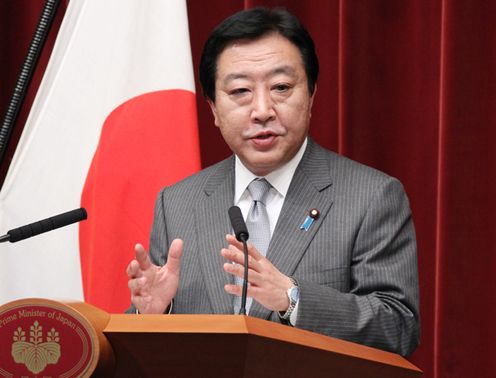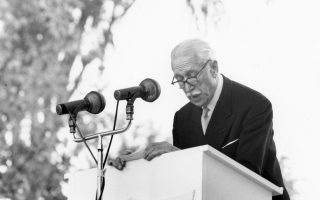marwaarsanios.info – Yoshihiko Noda served as the 95th Prime Minister of Japan from September 2011 to December 2012, during a period of significant political and economic challenges. Noda, a member of the Democratic Party of Japan (DPJ), took office in the aftermath of the devastating 2011 Great East Japan Earthquake and the ensuing Fukushima Daiichi nuclear disaster. His leadership was marked by efforts to address Japan’s economic stagnation, fiscal deficits, and the complex aftermath of the disaster, as well as attempts at political reforms. However, Noda’s time as prime minister was short and tumultuous, with his administration facing numerous challenges that ultimately led to his resignation.
Early Life and Political Career
Yoshihiko Noda was born on May 20, 1957, in Katori, Chiba Prefecture, Japan. His educational background includes a degree from the University of Tokyo’s Faculty of Economics, a prestigious institution that shaped his early understanding of economics and governance. Noda entered politics in the 1980s and was first elected to the House of Representatives in 1993. He was initially a member of the opposition and gradually rose through the ranks of the Democratic Party of Japan (DPJ), which had formed to challenge the long-dominant Liberal Democratic Party (LDP).
Noda’s political career was characterized by his focus on economic policy, fiscal responsibility, and social issues. As a member of the DPJ, Noda was known for his pragmatism and dedication to tackling Japan’s fiscal challenges, which would become a defining feature of his time as prime minister.
Becoming Prime Minister
In 2011, Japan was in the midst of multiple crises. The country had just experienced one of the most devastating natural disasters in its history—the Great East Japan Earthquake—which had caused massive loss of life and led to the catastrophic Fukushima Daiichi nuclear disaster. At the same time, Japan was struggling with economic stagnation, a growing national debt, and political instability. The DPJ’s first prime minister, Naoto Kan, had resigned amid criticism of his handling of the crisis, leaving a leadership vacuum in the country.
Yoshihiko Noda, who had been serving as Japan’s finance minister in Kan’s cabinet, was elected leader of the DPJ and subsequently became the prime minister on September 2, 2011. Noda inherited a fragile political situation, and his leadership was initially viewed as a stabilizing force in the face of the ongoing crisis.
Key Policies and Challenges
Noda’s prime ministership was dominated by efforts to address Japan’s pressing economic issues, manage the aftermath of the Fukushima nuclear disaster, and stabilize the political landscape.
The Fukushima Disaster and Nuclear Policy
One of Noda’s first and most significant challenges as prime minister was managing the fallout from the Fukushima Daiichi nuclear disaster, which occurred in March 2011, just months before he assumed office. The nuclear disaster had raised serious concerns about Japan’s energy policies and the safety of its nuclear power plants. Noda’s administration faced intense pressure to address the public’s fear of nuclear energy while also ensuring that Japan’s energy needs were met.
Noda initially took steps to restart some of Japan’s idled nuclear reactors in an attempt to reduce Japan’s reliance on imported fossil fuels. However, the decision was highly controversial, and public opposition to nuclear power grew. The Noda government was also under intense scrutiny for its handling of the Fukushima disaster, with many questioning the adequacy of the response and the safety measures in place for residents affected by radiation exposure. Despite these challenges, Noda remained committed to maintaining a balance between Japan’s energy needs and public safety concerns.
Economic and Fiscal Reforms
Another major focus of Noda’s leadership was addressing Japan’s economic and fiscal issues. Japan faced a rapidly rising national debt, which had exceeded 200% of its GDP, and Noda’s administration aimed to implement fiscal reforms that would reduce the deficit and stabilize public finances. A key part of this agenda was the proposed consumption tax increase, which Noda argued was necessary to secure the country’s social welfare system, particularly in light of Japan’s aging population.
In 2012, Noda’s government successfully passed legislation to raise the consumption tax from 5% to 10%, with the aim of addressing Japan’s long-term fiscal challenges. While this move was praised by some economists as necessary to stabilize Japan’s finances, it was deeply unpopular with the public and sparked protests. Critics argued that the tax hike would disproportionately affect low-income households and that the government had not done enough to address the broader issues of economic growth and inequality.
Political Instability and the Opposition
Noda’s tenure was also marked by political instability. The DPJ, which had enjoyed a historic victory in 2009, had begun to lose support due to its inability to deliver on promises of reform and the challenges it faced in managing the aftermath of the earthquake and nuclear disaster. The opposition LDP, led by Shinzo Abe, capitalized on the DPJ’s internal divisions and growing public dissatisfaction, making it difficult for Noda to maintain political momentum.
In addition, Noda’s leadership was frequently challenged by internal factions within the DPJ, which were divided over key policy decisions, particularly on the consumption tax and nuclear energy. The political gridlock and infighting weakened Noda’s position, and his inability to achieve comprehensive reform alienated both the public and his party.
The 2012 General Election
By the end of 2012, Noda’s government had faced severe criticism, both domestically and internationally, for its handling of key issues, including the economy, nuclear energy, and political dysfunction. Public dissatisfaction with the DPJ reached a tipping point, and Noda was forced to call a snap general election in December 2012, hoping to secure a mandate to continue his policies.
The election, however, resulted in a sweeping victory for the LDP, led by Shinzo Abe, who would go on to become Japan’s prime minister once again. The LDP’s win marked the end of Noda’s tenure as prime minister, and he resigned as the leader of the DPJ shortly after the party’s defeat.
Legacy and Conclusion
Yoshihiko Noda’s time as prime minister was marked by his attempts to navigate Japan through a period of crisis and economic instability. While he made significant efforts to address Japan’s fiscal challenges, including the unpopular consumption tax hike, his administration struggled to implement structural reforms that would have a lasting impact on the country’s economy and political landscape. The Fukushima disaster, political infighting, and public dissatisfaction ultimately led to his downfall.
Although Noda’s tenure was brief, his commitment to fiscal reform and his efforts to stabilize Japan’s political environment during a time of crisis are central to his legacy. However, his inability to unite his party, coupled with the challenges he faced in addressing public concerns over nuclear power and economic stagnation, overshadowed his achievements. Noda’s time as prime minister is often viewed as a transitional period, paving the way for Shinzo Abe’s return to power and the LDP’s resurgence.



